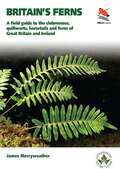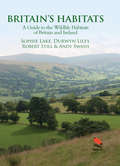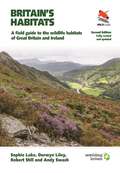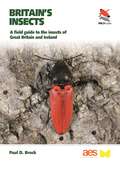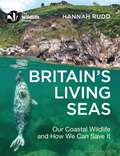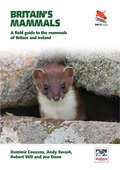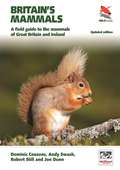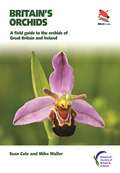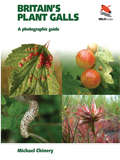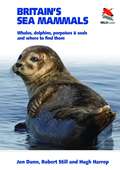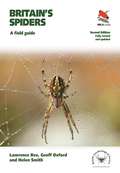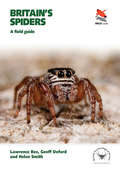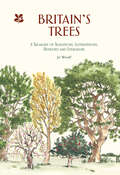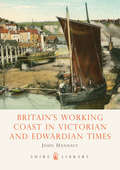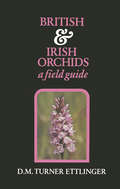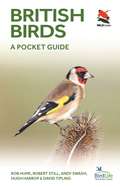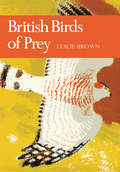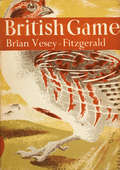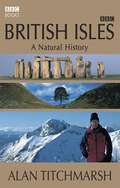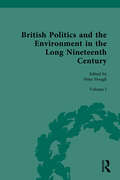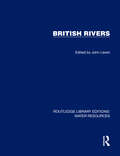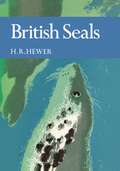- Table View
- List View
Britain's Ferns: A Field Guide to the Clubmosses, Quillworts, Horsetails and Ferns of Great Britain and Ireland (WILDGuides #31)
by James MerryweatherThe only comprehensive photographic guide to the ferns, clubmosses, quillworts and horsetails of BritainThis is a comprehensive, lavishly illustrated and user-friendly photographic identification guide to the fifty-seven ferns and seventeen other pteridophytes that occur in Britain. It is the perfect companion for botanists, naturalists, professional ecologists and anyone else with an interest in this fascinating group of non-flowering vascular plants. Designed to appeal to beginners and experts alike, this authoritative book includes novel identification keys and comparison tables that have been carefully devised to present only essential, easily understood technical terms and descriptions, avoiding jargon as much as possible. Cross-referenced throughout to facilitate the comparison of similar species, this definitive field guide is the go-to source for identifying these species with confidence.Features hundreds of stunning colour photographsComprehensive coverage of Britain's 57 species of ferns, 6 clubmosses, 3 quillworts and 8 horsetailsIncludes novel, easy-to-use, jargon-free identification keys and comparison tablesBeautifully designed, user-friendly and accessible
Britain’s Habitats: A Guide to the Wildlife Habitats of Britain and Ireland (PDF)
by Sophie Lake Durwyn Liley Robert Still Andy SwashA photographic guide to habitats, this lavishly illustrated book provides a comprehensive overview of the natural history and conservation landscape of Britain and Ireland. In essence a field guide, the book leads the reader through all the main habitat types, with information on their characteristics, extent, geographical variation, key species, cultural importance, origins and conservation. It aims to help visitors to the countryside recognize the habitats around them, understand how they have evolved and what makes them special, and imagine how they might change in the future.This book is the perfect companion for anyone travelling in Britain and Ireland, and essential reading for all wildlife enthusiasts, professional ecologists and landscape architects.Individual sections on all the main habitat types found in Britain and IrelandMore than 680 evocative colour photographs, including images from around Britain and Ireland in all seasonsDetails and photographs of key species and features associated with the different habitatsUp-to-date information—including maps—on the distribution, extent and importance of all habitat typesInformation on key nature conservation designations and different systems of habitat classification
Britain's Habitats: A Field Guide to the Wildlife Habitats of Great Britain and Ireland - Fully Revised and Updated Second Edition (WILDGuides #76)
by Sophie Lake Durwyn Liley Robert Still Andy SwashA comprehensive and lavishly illustrated photographic guide—now in a handy field-guide formatThis lavishly illustrated photographic guide provides a comprehensive overview of the natural history of wildlife habitats in Britain and Ireland. Now completely redesigned in a handy field-guide format, and featuring revised and updated text throughout, this new edition of Britain’s Habitats guides readers through all the main habitat types, presenting information on their characteristics, extent, geographical variation, key species, cultural importance, origins and conservation. It aims to help visitors to the countryside recognize the habitats around them, understand how they have evolved and what makes them special, and imagine how they might change in the future. This new edition includes updated maps and additional photographs throughout, and covers a new habitat—gardens. The perfect companion for anyone travelling in Britain and Ireland, the book is essential reading for all wildlife enthusiasts, professional ecologists and landscape architects.Individual sections on all the main habitat types found in Britain and IrelandMore than 680 evocative colour photographs, including images from around Britain and Ireland in all seasonsDetails and photographs of key species and features associated with the different habitatsUp-to-date information—including maps—on the distribution, extent and importance of all habitat typesFeatures new to this edition include a field-guide format, updated maps, more photographs throughout and coverage of an additional habitat—gardens
Britain's Insects: A Field Guide to the Insects of Great Britain and Ireland (WILDGuides #78)
by Dr. Paul D. BrockThe go-to photographic guide to Britain and Ireland’s insectsBritain’s Insects is an innovative, up-to-date, carefully designed and beautifully illustrated field guide to Britain and Ireland's twenty-five insect orders, concentrating on popular groups and species that can be identified in the field. Featuring superb photographs of live insects, the guide covers the key aspects of identification and provides information on status, distribution, seasonality, habitat, food plants and behaviour. It also offers insight into the life history of the various insect groups, many of which are truly amazing. This is the go-to guide for entomologists, naturalists, gardeners, wildlife photographers and anyone else interested in insects, whatever their level of knowledge.More than 2,600 stunning photographs, carefully selected to show key identification featuresPhoto guides to every insect order, covering 316 families and almost 850 generaCovers 1,653 species, of which 1,476 are illustratedDesigned to allow easy, accurate comparison of similar speciesUp-to-date distribution maps and charts summarizing adult seasonalityQR codes that link to sound recordings of grasshoppers and cricketsInformation on photographing and recording insects to help conservation
Britain's Living Seas: Our Coastal Wildlife and How We Can Save It
by Hannah RuddDiscover the incredible diversity of life within our seas and learn how we can all play a role in protecting and conserving it.Our seas are home to an abundance of fascinating creatures and stunning habitats. From spectacular kelp forests to intricate rocky reefs and from mud plains to open ocean, the British Isles have a diversity of marine ecosystems that rival those seen on any nature documentary. Yet, for generations, we have been slowly suffocating life beneath the waves. Decades of unsustainable exploitation, endless pollution and a warming climate have had a devastating effect on our marine habitats.However, it's not too late to make a difference and change course. Written in collaboration with the Wildlife Trusts, Britain's Living Seas provides a user-friendly and richly illustrated guide to coasts around the British Isles, uncovering the diversity of life within a range of marine habitats and the life-giving services that they provide us. Outlining how their very existence is under threat, marine biologist Hannah Rudd presents an alternative and sustainable future for the management of our seas. We can all do our bit as individuals too. Through practical steps such as re-thinking what we eat, our relationship with plastic and how we spend our money, we can become marine conservationists in our everyday lives and help to create a healthier future for our oceans. Everyone can discover more about the wonders within the waters that surround us and play a part in rebuilding our connection with the natural world.
Britain's Living Seas: Our Coastal Wildlife and How We Can Save It
by Hannah RuddDiscover the incredible diversity of life within our seas and learn how we can all play a role in protecting and conserving it.Our seas are home to an abundance of fascinating creatures and stunning habitats. From spectacular kelp forests to intricate rocky reefs and from mud plains to open ocean, the British Isles have a diversity of marine ecosystems that rival those seen on any nature documentary. Yet, for generations, we have been slowly suffocating life beneath the waves. Decades of unsustainable exploitation, endless pollution and a warming climate have had a devastating effect on our marine habitats.However, it's not too late to make a difference and change course. Written in collaboration with the Wildlife Trusts, Britain's Living Seas provides a user-friendly and richly illustrated guide to coasts around the British Isles, uncovering the diversity of life within a range of marine habitats and the life-giving services that they provide us. Outlining how their very existence is under threat, marine biologist Hannah Rudd presents an alternative and sustainable future for the management of our seas. We can all do our bit as individuals too. Through practical steps such as re-thinking what we eat, our relationship with plastic and how we spend our money, we can become marine conservationists in our everyday lives and help to create a healthier future for our oceans. Everyone can discover more about the wonders within the waters that surround us and play a part in rebuilding our connection with the natural world.
Britain's Mammals: A Field Guide to the Mammals of Britain and Ireland (PDF)
by Dominic Couzens Andy Swash Robert Still Jon DunnBritain's Mammals is a comprehensive and beautifully designed photographic field guide to all the mammals recorded in the wild in Britain and Ireland in recent times—including marine mammals, bats and introduced species that have bred. The book features hundreds of stunning photographs and incorporates invaluable tips and suggestions to help you track down and identify even the most difficult species. This easy-to-use book provides an introduction to the different types of mammal. Concise species accounts focus on identification and include up-to-date information on sounds, habitat, food, habits, breeding behaviour and population and status, as well as descriptions of key field signs—including tracks, droppings and nests—that give away the presence of mammals even when they are out of sight. In addition, guidance is provided on ways of studying and observing mammals—including small-mammal trapping, bat detecting and whale watching—as well as mammal conservation, legislation and further sources of useful information. Handy and informative, this guide is the ideal companion for anyone interested in watching mammals in Britain and Ireland. Comprehensive coverage of every mammal recorded in Britain and Ireland 500 superb colour photographs carefully selected to show key identification features Up-to-date distribution maps Detailed illustrations of tracks, dentition and other identification features Helpful tips for identifying tracks and other signs you may find in the field Latest information on status, population, distribution and conservation designations Advice on finding and watching mammals
Britain's Mammals Updated Edition: A Field Guide to the Mammals of Great Britain and Ireland (WILDGuides #81)
by Dominic Couzens Andy Swash Robert Still Jon DunnA comprehensive photographic field guide to the mammals of Great Britain and IrelandBritain’s Mammals is a comprehensive and beautifully designed photographic field guide to all the mammals recorded in the wild in Great Britain and Ireland in recent times—including marine mammals, bats and introduced species that have bred. The book features 500 stunning photographs and incorporates invaluable tips and suggestions to help you track down and identify even the most difficult species.This easy-to-use book provides an introduction to the different types of mammal. Concise species accounts focus on identification, and include up-to-date information on sounds, habitat, food, habits, breeding behaviour, and population and status, as well as descriptions of key field signs—including tracks, droppings and nests—that give away the presence of mammals even when they are out of sight. Guidance is also provided on ways of studying and observing mammals—including small-mammal trapping, bat detecting and whale watching. In addition, the book contains sections on mammal conservation, legislation and further sources of useful information. Handy and informative, this guide is the ideal companion for anyone interested in watching mammals in Great Britain and Ireland.Comprehensive coverage of all 126 mammal species recorded500 superb colour photographs carefully selected to show key identification featuresUp-to-date distribution mapsDetailed illustrations of tracks, dentition and other identification featuresHelpful tips for identifying tracks and other signs you may encounterLatest information on status, population, distribution and conservation designationsAdvice on finding and watching mammals
Britain's Orchids: A Field Guide to the Orchids of Great Britain and Ireland (WILDGuides #43)
by Sean Cole Mike WallerAn accessible, comprehensive and beautifully illustrated guide—the only one to cover all the orchids found in Britain and IrelandCovering all fifty-one native species and twelve of uncertain origin, as well as hybrids and variants, Britain’s Orchids is an engaging, intuitive and in-depth identification guide to all the orchids of Britain and Ireland at all stages of development, from first emergence to setting seed. Drawing on the authors’ extensive field experience and the latest scientific research, the book uses multiple techniques to help both beginner and more advanced orchid enthusiasts to identify even the most difficult plants. It is beautifully illustrated with watercolour paintings by talented artist Sarah Stribbling, and features more than 1,200 evocative, instructive and detailed photographs. Orchids have long fired the imagination with their beauty and rarity. This book aims to ignite or increase your passion for these special plants, and for the conservation of their varied habitats—from remote mountaintops to urban wild spaces.The first book to cover all the species at all stages of development, as well as all subspecies, varieties and confirmed hybridsLavishly illustrated with 98 beautiful watercolour platesMore than 1,200 stunning photos showing the orchids in their natural settings and highlighting key identification featuresSimple, step-by-step system for identifying almost any orchid you encounterUp-to-date distribution maps and seasonal charts showing when each species can be seen in its various stages of developmentSean Cole is a field naturalist who has been studying orchids for more than twenty years, with special interests in identification, taxonomy and pollination. He has published many articles on British orchids, including his specialty, the Ghost Orchid. Mike Waller is an ecologist and botanist who specializes in European orchids. He has worked for the Royal Society for the Protection of Birds, the Natural History Museum in London, the London Wildlife Trust and Plantlife.
Britain's Plant Galls: A Photographic Guide (PDF)
by Michael ChineryThis book has been produced with the aim of stimulating the general naturalist to take a closer look at the bumps and lumps that make up the fascinating world of plant galls. Induced by a variety of insects and other organisms and ranging from tiny pimples to bizarre and often very attractive and exquisitely sculptured growths, plant galls are mystery to many people, but they offer a fascinating field of study for both botanists and zoologists. Galls can be found on a very wide range of both woody and herbaceous plants, with over 50 different kinds occurring on Britain's oak trees alone, and there is still much to be learned about even the commonest examples. An introduction to the nature of plant galls and their formation Brief descriptions of some of the organisms that cause or induce galls Superb photographs of just over 200 of the commonest or most conspicuous of Britain's 1,000 or so plant galls, arranged according to their host plants to aid field identification Descriptions of these galls and the life histories of the organisms that cause them
Britain's Sea Mammals: Whales, Dolphins, Porpoises, and Seals and Where to Find Them (PDF)
by Jon Dunn Robert Still Hugh HarropBritain's Sea Mammals is the essential field guide to all the sea mammals--whales, dolphins, porpoises, and seals--found in coastal Britain. The book features more than 100 stunning photographs and close to 40 detailed and beautiful illustrations of 34 species of sea mammals, paying special attention to the 14 species most readily seen and most likely to be encountered. Factoring in behavior and locations, introductory chapters look at sea mammal biology and ecology, and how, when, and where these creatures can be spotted. Species accounts highlight key identification characteristics and include information on status, habitat requirements, and distribution. Handy and informative, Britain's Sea Mammals is the ideal guide to sea mammal watching in the United Kingdom. The only guide that focuses on the 34 species of sea mammal recorded in Britain, particularly the 14 most readily seen species More than 100 photos and almost 40 illustrations highlight species, their behavior, and locations Introductory chapters explore how, when, and where to look for sea mammals Species accounts highlight key identification features, including information on status, habitat requirements, and distribution
Britain's Spiders: A Field Guide – Fully Revised and Updated Second Edition (WILDGuides #77)
by Britain's Spider Lawrence Bee Britain's Spider Geoff Oxford Britain's Spider Helen SmithA comprehensively updated edition of an identification guide that was named a Guardian Best Nature Book of the YearNow in a comprehensively revised and updated new edition, Britain’s Spiders is a guide to all 38 of the British families, focussing on spiders that can be identified in the field. Illustrated with a remarkable collection of photographs, it is designed to be accessible to a wide audience, including those new to spider identification. This book pushes the boundaries of field identification for this challenging group, combining information on features that can be seen with the naked eye or a hand lens with additional evidence from webs, egg sacs, behaviour, phenology, habitats and distributions. Individual accounts cover 404 species—all of Britain’s “macro” spiders and the larger money spiders, with the limitations to field identification clearly explained. This new edition includes nine species new to Britain, many recent name changes, updated distribution maps and species information, new guides to help identify spider families and distinctive species, and the latest species checklist.A guide to spider families, based on features recognizable in the field, focussing on body shape and other characteristics, as well as separate guides to webs and egg-sacsDetailed accounts and more than 700 stunning photographs highlight key identification features for each genus and species, and include information on status, behaviour and habitatsUp-to-date distribution maps, and charts showing adult seasonalityIntroductory chapters on the biology of spiders, and where, when and how to find them, including equipment needed in the fieldA complete list of the spiders recorded in Britain, indicating the ease of identification as well as rarity and conservation statusInformation on how to record spiders and make your records count, and guidance on how to take your interest furtherNew to this edition: coverage of nine species new to Britain, updated species information and distribution maps, identification guides to spider families and distinctive species, and the latest species checklist
Britain's Spiders: A Field Guide (PDF)
by Lawrence Bee Geoff Oxford Helen SmithBritain’s Spiders is a photographic guide to all 37 of the British families, focussing on spiders that can be identified in the field. Illustrated with a remarkable collection of photographs, it is designed to be accessible to a wide audience, including those new to spider identification. This book pushes the boundaries of field identification for this challenging group by combining information on features that can be seen with the naked eye or a hand lens with additional evidence from webs, egg-sacs, behaviour, phenology, habitats and distributions. Individual accounts cover 395 of Britain’s approximately 670 species, with the limitations to field identification clearly explained. As the first photographic field guide to British spiders to be published since 1989, this book fills a major gap in the resources available to everyone with an interest in this fascinating, diverse and important group of animals. More than 700 stunning photographs Includes a guide to spider families, based on features recognisable in the field, focussing on body shape and other characteristics, as well as separate guides to webs and egg-sacs Detailed accounts highlight key identification tips for each genus and species, and include information on status, behaviour and habitats Features up-to-date distribution maps, and charts showing adult seasonality Introductory chapters explore the biology of spiders, and where, when and how to find them, including equipment needed in the field Contains a complete list of the spiders recorded in Britain, indicating the ease of identification as well as rarity and conservation status Provides information on how to record spiders and make your records count, and guidance on how to take your interest further
Britain's Trees: A Treasury Of Traditions, Superstitions, Remedies And Literature
by Jo Woolf National Trust BooksA cornucopia of some of Britain's oldest and most beloved native trees, this book weaves together their rich history, folklore and traditions.
Britain's Working Coast in Victorian and Edwardian Times (Shire Library #548)
by John HannavyThe coastline of Victorian and Edwardian Britain provided beauty, entertainment and the venue for most people's holidays. But it was also a thriving centre of industry shipbuilding and fishing, plus the numerous trades associated with dockyards, coastal transport and the leisure industry. This book travels around Britain's coast clockwise from London looking at the industries that could be found at many of the cities and towns en route. Illustrated with an amazing collection of coloured postcards and other early photographs, the working coast of Britain is brought to life in all its bustling detail.
British Birds: A Pocket Guide (Wildguides Ser. #30)
by Rob Hume Robert Still Andy Swash Hugh Harrop David TiplingA carefully designed and lavishly illustrated photographic guideThis innovative and carefully designed photographic guide provides a concise introduction to the identification of the 246 birds most likely to be seen in Great Britain and Ireland. It is the perfect book for anyone wanting to put a name to the birds in their garden, local area or on visits farther afield. Packed with hundreds of stunning photos showing the birds in their many variations, and written and designed by a team of experienced birdwatchers, this is the ideal companion for anyone interested in learning more about the wild birds around us.Covers the 246 birds most likely to be seen, plus another 30 or so scarce but regular migrantsCarefully designed to be user-friendly and accessibleLavishly illustrated with more than 1,000 stunning colour photographsEasy to use and written in plain English
British Birds of Prey (Collins New Naturalist Library #60)
by Leslie. H. BrownLeslie Brown's account of our 15 resident, 7 vagrant and 2 migrant species of eagles, falcons, hawks and vultures in Britain presents a great mass of scientific information about our birds of prey in a manner as attractive to the general reader as to the dedicated ornithologist.
British Game (Collins New Naturalist Library #2)
by Brian Vesey-FitzgeraldBritish Game ranges beyond the strict legal interpretation of game and is full of interesting details about the birds and beasts that should interest sportsmen. This edition is exclusive to newnaturalists.com
British Isles: A Natural History
by Alan TitchmarshAccompanying a major new BBC1 series presented by Alan Titchmarsh, British Isles: A Natural History is a fascinating journey through the natural history of Britain from its birth to the present day. Written in Alans uniquely readable style, the book chronicles the different periods in Britain's evolution, exploring everything from the geology and geography to the flora and fauna that make up the diverse landscapes of the British Isles. It also includes a gazetteer section detailing where you can explore for yourself Britain's natural treasures. Beautifully illustrated with 180 colour photographs, it will appeal to natural history enthusiasts and everyone who cares about the country they live in. The book contains the latest research gathered in the making of this new landmark series from the BBC's NHU in Bristol. Alan Titchmarsh is a bestselling BBC author and has sold over a million copies of his books which include How To Be A Gardener 1 and 2 and Royal Gardeners.
British Politics and the Environment in the Long Nineteenth Century: Volume I - Discovering Nature and Romanticizing Nature
by Peter HoughThis volume of archival source material chronicles British environmental politics between 1789 and 1914. This text examines scientific discoveries during this period and the result of these findings on the political environment, bringing the public's attention to public health issues such as acid rain and river pollution. Accompanied by extensive editorial commentary, this collection will be of great interest to students of environmental and political history.
British Politics and the Environment in the Long Nineteenth Century: Volume I - Discovering Nature and Romanticizing Nature
by Peter HoughThis volume of archival source material chronicles British environmental politics between 1789 and 1914. This text examines scientific discoveries during this period and the result of these findings on the political environment, bringing the public's attention to public health issues such as acid rain and river pollution. Accompanied by extensive editorial commentary, this collection will be of great interest to students of environmental and political history.
British Rivers (Routledge Library Editions: Water Resources)
by John LewinOriginally published in 1981, this book describes and interprets the physical nature of British rivers and is authored by leading authors from universities, the Institute of Hydrology and a water Authority. The contents include data on river regimes and catchment characteristics, information on water quality in both polluted and unpolluted rivers, a full discussion of river channels and their erosion and sediment characteristics, and a consideration of river management problems in the distinctive British context. Where possible, nationwide information is presented in map form and many of the maps presented a national picture for the first time. The book will be of interest to students and scientists in a wide range of disciplines: geography, geology, environmental science, hydrology and engineering. Those professionally engaged in environmental management and the water industry should also find it useful. In summary, all who are concerned with rivers – as agents of landscape change, sedimenting phenomena, environmental resources or flood hazards will find this book as relevant now as when it was first published.
British Rivers (Routledge Library Editions: Water Resources)
Originally published in 1981, this book describes and interprets the physical nature of British rivers and is authored by leading authors from universities, the Institute of Hydrology and a water Authority. The contents include data on river regimes and catchment characteristics, information on water quality in both polluted and unpolluted rivers, a full discussion of river channels and their erosion and sediment characteristics, and a consideration of river management problems in the distinctive British context. Where possible, nationwide information is presented in map form and many of the maps presented a national picture for the first time. The book will be of interest to students and scientists in a wide range of disciplines: geography, geology, environmental science, hydrology and engineering. Those professionally engaged in environmental management and the water industry should also find it useful. In summary, all who are concerned with rivers – as agents of landscape change, sedimenting phenomena, environmental resources or flood hazards will find this book as relevant now as when it was first published.
British Seals (Collins New Naturalist Library #57)
by H. R. HewerA comprehensive account of the seal’s migratory patterns, methods of hunting and patterns of reproduction.
